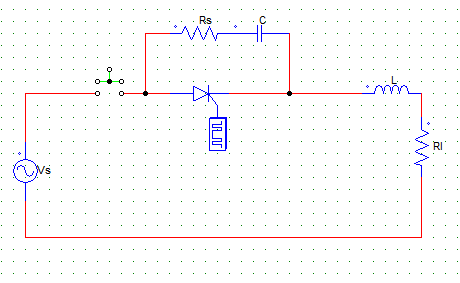This set of Power Electronics Multiple Choice Questions & Answers (MCQs) focuses on “Thyristor Protection”.
1. di/dt protection is provided to the thryistor by
a) connecting an inductor in parallel across the load
b) connecting an inductor in series with the load
c) connecting an inductor in parallel across the gate terminal
d) connecting an inductor in series with the gate
View Answer
Explanation: By placing the di/dt inductor (L) in series with the load, the change in the anode current can be limited to a small value.
2. The local hot spot formation in the cross-section of the SCR is avoided by
a) reducing the junction temperature
b) applying gate current nearer to the maximum gate current
c) using only R loads
d) proper mounting of the SCR on heat sink
View Answer
Explanation: Applying the higher gate current spreads the ions quickly and avoids hotspot formation.
3. The dv/dt protection is provided in order to
a) limit the power loss
b) reduce the junction temperature
c) avoid accidental turn-on of the device
d) avoiding sudden large voltage across the load
View Answer
Explanation: Accidentally some voltage spike or noise may occur in the vicinity of the device, if the magnitude is large enough it may turn on the SCR.
4. dv/dt protection is provided to the SCR by
a) connecting a capacitor in parallel with the load
b) connecting an inductor in series with the load
c) connecting a capacitor & resister in parallel with the device
d) connecting an inductor & resister in parallel with the device
View Answer
Explanation: Snubber circuit R-C in parallel with SCR is connected for dv/dt protection.
5. Figure below shows SCR having dv/dt and di/dt protection, when the switch(shown in green) is closed the current through Rl =

a) I(1 – e-t/τ)
b) I(1 + e-t/τ)
c) I(1 – et/τ)
d) I(1 + e-t/τ)
View Answer
Explanation: As soon as the switch is closed, C acts like a S.C & the voltage equation gives
Vs = (Rs + Rl) I + L di/dt
Solve the above D.E.
6. The effect of over-voltages on SCR are minimized by using
a) RL circuits
b) Circuit breakers
c) Varistors
d) di/dt inductor
View Answer
Explanation: Varistors are non-linear voltage clamping devices, RC circuits across the loads can also be used.
7. Over-current protection in SCRs is achieved through the use of
a) Varistors
b) Snubber Circuits
c) F.A.C.L.F & C.B.
d) Zener diodes
View Answer
Explanation: FACLF stands for Fast Acting Current Limiting Fuse.
8. False triggering of the SCRs by varying flux & noise is avoided by using
a) F.A.C.L.F & C.B
b) Shielded cables & twisted gate leads
c) Snubber circuits
d) di/dt inductor in series with the gate terminal
View Answer
Explanation: Shielded cables provide isolation from outside noise.
9. The thyristor has the following specifications
Vs = 400 V
(di/dt)max = 25 A/μsec
Find the value of L

a) 8 μH
b) 80 μH
c) 16 μH
d) 160 μH
View Answer
Explanation: As soon as the switch is closed, C acts like a S.C & the voltage equation gives,
Vs = (Rs + Rl) I + L di/dt
Solve the above D.E.
di/dt = Vs/L e-t/τ
di/dt is maximum at t = 0, substitute the above given values & find L
10. Thyristors are used in electronic crowbar protection circuits because it possesses
a) high surge current capabilities
b) high amp 2-sec rating
c) less switching losses
d) voltage clamping properties
View Answer
Explanation: Crowbar protection circuits have high surge current capabilities.
Sanfoundry Global Education & Learning Series – Power Electronics.
To practice all areas of Power Electronics, here is complete set of 1000+ Multiple Choice Questions and Answers.
If you find a mistake in question / option / answer, kindly take a screenshot and email to [email protected]
